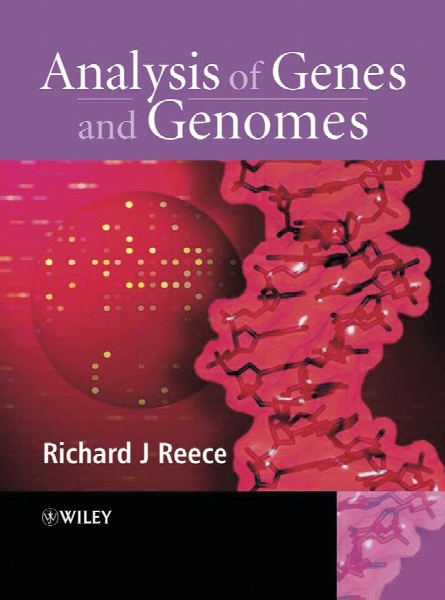Analysis of genes and genomes
- نوع فایل : کتاب
- زبان : انگلیسی
- مؤلف : Richard J Reece
- ناشر : Chichester, West Sussex, England ; Hoboken, NJ : John Wiley & Sons,
- چاپ و سال / کشور: 2004
- شابک / ISBN : 9780470091579
Description
Preface xiii Acknowledgements xv Abbreviations and acronyms xvii 1 DNA: Structure and function 1 1.1 Nucleic acid is the material of heredity 2 1.2 Structure of nucleic acids 7 1.3 The double helix 11 1.3.1 The antiparallel helix 12 1.3.2 Base pairs and stacking 14 1.3.3 Gaining access to information with the double helix without breaking it apart 16 1.3.4 Hydrogen bonding 17 1.4 Reversible denaturing of DNA 18 1.5 Structure of DNA in the cell 21 1.6 The eukaryotic nucleosome 24 1.7 The replication of DNA 28 1.8 DNA polymerases 31 1.9 The replication process 33 1.10 Recombination 37 1.11 Genes and genomes 39 1.12 Genes within a genome 40 1.13 Transcription 43 1.13.1 Transcription in prokaryotes 43 1.13.2 Transcription in eukaryotes 46 1.14 RNA processing 54 1.14.1 RNA splicing 55 1.14.2 Alternative splicing 58 1.15 Translation 59 2 Basic techniques in gene analysis 65 2.1 Restriction enzymes 66 2.1.1 Types of restriction–modification system 70 2.1.2 Other modification systems 724.8 RT–PCR 177 4.9 Real-time PCR 179 4.10 Applications of PCR 181 5 Cloning a gene 183 5.1 Genomic libraries 185 5.2 cDNA libraries 191 5.3 Directional cDNA cloning 196 5.4 PCR based libraries 199 5.5 Subtraction libraries 200 5.6 Library construction in the post-genome era 204 6 Gene identification 205 6.1 Screening by nucleic acid hybridization 206 6.2 Immunoscreening 211 6.3 Screening by function 216 6.4 Screening by interaction 217 6.5 Phage display 218 6.6 Two-hybrid screening 218 6.6.1 Problems, and some solutions, with two-hybrid screening 225 6.7 Other interaction screens – variations on a theme 228 6.7.1 One hybrid 229 6.7.2 Three hybrid 229 6.7.3 Reverse two hybrid 229 7 Creating mutations 231 7.1 Creating specific DNA changes using primer extension mutagenesis 233 7.2 Strand selection methods 237 7.2.1 Phosphorothioate strand selection 237 7.2.2 dut− ung− (or Kunkel) strand selection 238 7.3 Cassette mutagenesis 240 7.4 PCR based mutagenesis 241 7.5 QuikChange mutagenesis 248 7.6 Creating random mutations in specific genes 250 7.7 Protein engineering 254 8 Protein production and purification 257 8.1 Expression in E. coli 258 8.1.1 The lac promoter 25910.5 Genome-wide two-hybrid screens 333 10.6 Protein detection arrays 335 10.7 Structural genomics 335 11 Engineering plants 341 11.1 Cloning in plants 341 11.1.1 Agrobacterium tumefaciens 342 11.1.2 Direct nuclear transformation 347 11.1.3 Viral vectors 348 11.1.4 Chloroplast transformation 350 11.2 Commercial exploitation of plant transgenics 354 11.2.1 Delayed ripening 354 11.2.2 Insecticidal resistance 355 11.2.3 Herbicidal resistance 356 11.2.4 Viral resistance 357 11.2.5 Fungal resistance 358 11.2.6 Terminator technology 358 11.3 Ethics of genetically engineered crops 360 12 Engineering animal cells 361 12.1 Cell culture 361 12.2 Transfection of animal cells 362 12.2.1 Chemical transfection 363 12.2.2 Electroporation 364 12.2.3 Liposome-mediated transfection 364 12.2.4 Peptides 366 12.2.5 Direct DNA transfer 366 12.3 Viruses as vectors 367 12.3.1 SV40 367 12.3.2 Adenovirus 369 12.3.3 Adeno-associated virus (AAV) 371 12.3.4 Retrovirus 372 12.4 Selectable markers and gene amplification in animal cells 375 12.5 Expressing genes in animal cells 378 13 Engineering animals 379 13.1 Pronuclear injection 381 13.2 Embryonic stem cells 384 13.3 Nuclear transfer 390 13.4 Gene therapy 396 13.5 Examples and potential of gene therapy 398Glossary 401 Proteins 409 A1.1 409 A1.2 410 A1.3 411 Nobel prize winners 413 References 417 Index 459


